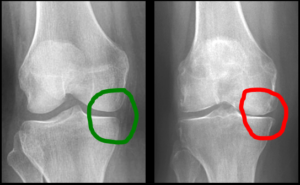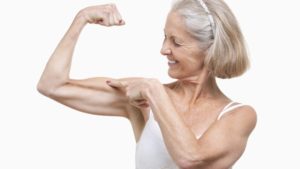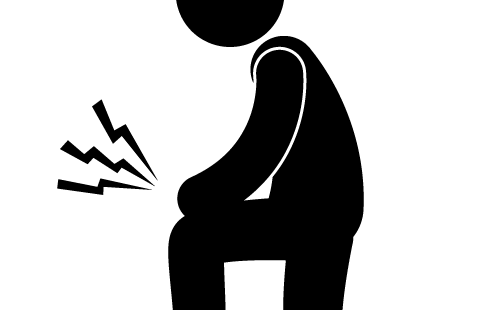Written by: Sarah K. Greenhagen, DPT, GCS (@sarahgreenhagen)
Maybe this sounds familiar….
You’ve started having pain while walking around the yard and going down the stairs and you’re getting frustrated. You approach your physician about your pain and frustrations and an X-ray is ordered. Maybe this worries you; Is something wrong? Injured perhaps? Breaking down? you wonder….You get a call back that tells you that you have moderate Osteoarthritis (OA) and “we can start with injections.”  But your questions remain unanswered. Is something injured, breaking down? What is Osteoarthritis? Why am I being offered injections, will they fix the problem or mostly mask the symptoms? What about my pain, why do I have pain? Maybe this sounds too familiar….maybe it’s time to learn more….
But your questions remain unanswered. Is something injured, breaking down? What is Osteoarthritis? Why am I being offered injections, will they fix the problem or mostly mask the symptoms? What about my pain, why do I have pain? Maybe this sounds too familiar….maybe it’s time to learn more….
Let’s start with why we think OA occurs, what we can do about it to decrease your pain and how we can work together to get you back to (a) doing what you love and (b) living the high quality of life we all want!
Context…
Globally, we are living longer; giving us more time to spend with our families and friends, doing what we enjoy….and IF we have a body that moves well enough to do so, we can enjoy a quality of our life (QOL) that can make it a great phase of life. QOL is a measurable index which attempts to quantify our physical and mental health as a direct link to our happiness through functional status, social support, etc.1 and there are many factors that can influence it. Some factors can be “pre-ordained” by our genetics, while others hinge on our health and lifestyle choices we make along the way.2 However, it is the combination of the two, the cards we are dealt AND how we manage them, that influence whether we will become one of the millions who have poorer quality of life because of chronic illness and disease.2
Can we measure whether or not treatments actually work?
From the individual level to the economic structure of the nation, Chronic Disease and illness impacts population health.3 It is a major piece of healthcare expenditure, making up 86% of our nation’s healthcare costs and is analyzed by healthcare and government funded institutions, on a larger scale, to determine cost containment measures.4 Healthcare economic analyses strive to determine the cost-effectiveness and cost-utility of healthcare interventions to address chronic disease and illness such as Osteoarthritis, Diabetes, Hypertension, etc.5
Did you say, ‘Osteo’arthritis?
Arthritis is a broad category of over 100 conditions that originate with inflammation of joints leading to symptoms of stiffness, decreased function, and/or chronic pain.6 Osteoarthritis (OA), is a subset of Arthritis that is classified by bone and cartilage “wear and tear” (degeneration) which often leads to inflammation. It is the most common form of Arthritis and can be broken down into two classes: Primary which is highly correlated with age and Secondary, resulting from infection, joint injury, and hereditary, metabolic, developmental or neurologic disorders. Pain, stiffness, and decreased motion are common daily symptoms for people dealing with Osteoarthritis making it exceedingly difficult to complete everyday tasks such as going up and down stairs, walking or even standing for long periods of time.
Though strikingly common, at least 24% of the population has knee OA, there is no cure; HOWEVER, there are a variety of treatment options focused on addressing the symptoms of OA8 and slowing its progression. These treatments range from supplements such as Glucosamine and chondroitin sulphate to intra-articular steroid or hyaluronic acid injections, non-steroidal anti-inflammatories (NSAIDs), acetaminophen and Physical Therapy.7,9 Interestingly, the type of treatment you are most likely to be prescribed often has more to do with:
- your weight and
- the type of Physician Specialist you see
than what the science says is the most effective treatment.9 (yikes!)
What actually works for Osteoarthritis?
In studying cost-effectiveness, researchers spend time analyzing outcomes of different treatments to see which has the largest margin of success combined with the lowest cost for a population of people with a particular condition, such as OA.5 Physical Therapy has been shown to be the cost-effective treatment for hip and knee osteoarthritis as well as low back pain, with a high rate of symptom reduction and low cost.5
 As a non-invasive treatment, successful Physical Therapy treatments most often contain:
As a non-invasive treatment, successful Physical Therapy treatments most often contain:
- exercise
- manual therapy
- education of activity and lifestyle modification to meet your goals and decrease chronic pain.
Exercise, alone, has been shown to increase QOL by improving physical and mental health, and decreasing associated pain and stiffness.5
Looking for real solutions? Look no further!
If you have been diagnosed with Osteoarthritis and have been left with unanswered questions, a local Physical Therapist is a great place to start. A Physical Therapist will evaluate you and provide you with real solutions to get you back on the right track! We have the right tools, not only to help with your symptoms, but get to the crux of the problem, the mobility, motor control, and strength limiters that need correction to get you back in the yard, out on the path, or back to work.
___________________
 Sarah K. Greenhagen, DPT, GCS earned her bachelors in Pre-Physical Therapy and her Doctorate of Physical Therapy from Northern Illinois University. She is a Board Certified Physical Therapist as a Geriatric Specialist. Sarah treats patients in a variety of settings and has developed the Total Joint Replacement Outcomes Measurement Program to bridge the disparity between prior level of function and post-surgical level of function. She also advises clients as a health coach for Pre-Diabetes/Diabetes and Pre-Hypertension/Hypertension Health and Wellness programs. She is deeply interested in community and population health and leads community seminars on Balance and Falls. Treating patients dealing with chronic illness and pain are her passion and she believes in the power of hope and determination. She enjoys consulting on community projects to promote health and wellness and is available to talk about ongoing community programs or new ideas to increase Health Literacy. Connect with Sarah at skgreenhagen@gmail.com or @sarahgreenhagen on Twitter .
Sarah K. Greenhagen, DPT, GCS earned her bachelors in Pre-Physical Therapy and her Doctorate of Physical Therapy from Northern Illinois University. She is a Board Certified Physical Therapist as a Geriatric Specialist. Sarah treats patients in a variety of settings and has developed the Total Joint Replacement Outcomes Measurement Program to bridge the disparity between prior level of function and post-surgical level of function. She also advises clients as a health coach for Pre-Diabetes/Diabetes and Pre-Hypertension/Hypertension Health and Wellness programs. She is deeply interested in community and population health and leads community seminars on Balance and Falls. Treating patients dealing with chronic illness and pain are her passion and she believes in the power of hope and determination. She enjoys consulting on community projects to promote health and wellness and is available to talk about ongoing community programs or new ideas to increase Health Literacy. Connect with Sarah at skgreenhagen@gmail.com or @sarahgreenhagen on Twitter .
References:
- http://www.cdc.gov/hrqol/concept.htm accessed 7/10/16
- Curtis, C., Goldberg, A., Kleim, J., and Wolf, S. Translating Genomic Advantages to Physical Therapist Practice: A Closer Look at the Nature and Nurture of Common Diseases.Phys Ther.2016;96:570-580.
- http://www.cdc.gov/about/organization/mission.htm accessed 7/10/16
- http://www.cdc.gov/chronicdisease/index.htm accessed 7/10/2016
- Burge, E., Monnin, D., Berchtold, A., and Allet, L.Cost-effectiveness of Physical Therapy Only and of Usual Care for Various Health Conditions: Systematic Review.Phys Ther.2016;96:774-786.
- http://www.cdc.gov/arthritis/basics/types.html accessed 7/10/16
- Batool, F., et al.Clinical Effectiveness of Glucosamine and Chondroitin Sulphate in Treatment of Osteoarthritis.International Journal of Pharmaceutical Sciences and Research.2015;6(2):541-45.
- Hinman, R., et al. Physical Therapists, Telephone Coaches, and Patients with Knee Osteoarthitis: Qualitative Study About Working Together to Promote Exercise Adherence.Phys Ther.2016;96:479-493.
- Forrester, K., et al. Comparision of knee osteoarthritis treatment in the non-obese vs obese populations across different medical specialities.Osteoarthritis and Cartilage.2015;23:A202.

